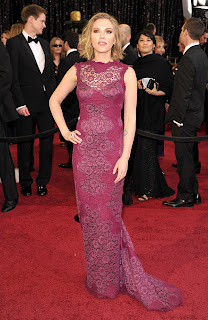As promised and for what it's worth, an outline of my presentation in two weeks. It might not help anyone else, but I find outlines, as opposed to prose, sometimes more helpful to my understanding. I focused on androgyny almost entirely and found the relevant information in the readings. I will also come with a more informed reading of Judith Butler in a few days. Don't miss the lyrics to a Replacements song at the end of the outline. Any thoughts as to their meaning? There is some ambiguity--just like androgyny itself, right?
Feminists’ Views on Androgyny
Bruzzi, Stella. “The Erotic Strategies of Androgyny.” Undressing Cinema: Clothing and Identity in the Movies. (Routledge, 1997.)
Key Terms from Dictionary.com:
Androgynous: Both Male and Female OR Sexually Ambiguous (“The Body”)
Hermaphroditic: Both Male and Female Sexual Organs (“The Body”)
Cross-Dressing: To Wear Clothing Usually Worn by the Opposite Sex (External, Masquerade)
Transvestic: To Wear Clothing Usually Worn by the Opposite Sex to Satisfy Sexual, Psychological Desire (“The Body” and External)
CLIP:
Morocco (von Sternberg, 1932) with Marlene Dietrich
*Deitrich: Aloof – appealing to men and women in the film audience.
*Stakes claim for androgyny and cross-dressing
*Cross-dressing: a collision of genders that are “nevertheless identifiable” (176).
*Dietrich as androgyne: “…multiple erotic identification…” (174).
*Double Observance: The audience in the film. The audience in the cinema (174).
*Androgyny: “blurred sex” (174); “the diminution of difference” (176); “a softening of the contours between corporeality and metaphor, male and female, straight and gay, real and imagined” (176).
*Sontag: “sexual attractiveness consists in going against the grain of one’s sex” (177).
*Sontag: androgyny is an exaggeration; “hysterical;” “camp” (Jayne Mansfield, for instance) (177).
*Fashion: Androgynous Style (trousers, coats): “hiding femininity” (177).
*Difference between “masculinity of the clothes and femininity of the body” (177).
*Yves Saint-Laurent: “woman who dresses like a man must be infinitely feminine in order to wear clothes which were not meant for her” (178).
*Calvin Klein: androgyny “synonymous with pubescence and precocious sexuality” (178).
*Jean-Paul Gartier: feminine men’s fashions: male skirt
*Klein and Saint-Laurent: sensuality of clothing. Gartier concerned with the intellectual transgressive potential of cross-dressing” (178).
*androgyny: “sexual attraction grounded in unease and doubt” (192).
*indication of tranformation.
*Dollimore: androgyny a “genderless transcendent which leaves sexual difference in place” (198).
*eroticism of androgynous ambiguity vs. non-sexual state
*androgyny (not cross dressing): “possesses the capacity for mutability and transformation” (199).
*androgynous clothing: “forms of consolidation and social communication” and “testaments of fantasy and desire."
Bordo, Susan. “‘Material Girl:’ The Effacements of Postmodern Culture.” Unbearable Weight: Feminism, Western Culture, and the Body. Univ. of California, 1993. 269-75.
*old Madonna: “fleshy, feminine,” refusing the androgynous styles of today(269)
*new Madonna: lost weight, exercises out of embarrassment and shame.
*in “Open Your Heart:” final scene: changes into little boy’s clothes: sexual identity becomes play and nonsexual pleasure; a refusal
*night: porn; day: an androgynous innocence
Berry, Sarah. “Suitably Feminine.” Screen Style: Fashion and Femininity in 1930s Hollywood. Univ. of Minnesota Press, 2000. 142-89.
*1930s: the working woman portrayed in films: transgressive
*many trans- associated with androgyny
*more female spectators “working outside the home” (143).
*Garbo: men’s clothes “for camouflage as well as comfort” (145).
*Morocco: film audience in caberat scene: rude disapproval changed to applause
*Dietrich: does not wear men’s clothing “to be sensational” but “thinks she’s more
alluring (146).
*Dietrich: men’s clothes worn offscreen as well
*gender contrast: women’s body vs. men’s clothes
*Deitrich: associations withEuropean lesbianism sought “male voyeuristic interest.”
*perhaps “appealing to female viewers of color whose sexuality did not rely on identification” (147).
*women’s play with gendered dress “increased freedom to move between social roles and identities” (148).
*athletic clothing, boilersuits, overalls, pajamas
*Garber: cross-dressing: “a sign of the provocative destabilization of gender;” “not just a category crisis of male and female, but the crisis of category itself (151).
SONG:
The Replacements. “Androdynous.”
Written by Paul Westerberg
(my own comments are in brackets)
Here come Dick, he's wearing a skirt
Here comes Jane, y'know she's sporting a chain
Same hair, revolution [song from 1984; possible Prince reference?]
Same build, evolution
Tomorrow who's gonna fuss [in the future there will be androgynous bodies]
And they love each other so
Androgynous
Closer than you know, love each other so
Androgynous
Don't get him wrong and don't get him mad
He might be a father [sexual reproduction], but he sure ain't a dad [androgyne not loving or responsible?]
And she don't need advice that'll center her [a center residing between male and female poles]
She's happy with the way she looks
She's happy with her gender
And they love each other so
Androgynous
Closer than you know, love each other so
Androgynous
Mirror image, see no damage
See no evil at all
Kewpie [hard to tell the sex; looks like Teletubby] dolls and urine stalls
Will be laughed at
The way you're laughed at now [in an androgynous future, heteronormative disappears]
Now, something meets Boy
And something meets Girl
They both look the same
They're overjoyed in this world
Same hair, revolution
Unisex, evolution
Tomorrow who's gonna fuss
And tomorrow Dick is wearing pants [clothes, fashion]
And tomorrow Janie's wearing a dress
Future outcasts and they don't last
And today, the people dress the way that they please
The way they tried to do in the last centuries [traditional notions of gender, i.e eunichs]
And they love each other so
Androgynous
Closer than you know, love each other so
Androgynous




 Did you know that today is a "Day of Rage" across the Muslim world, where bone-weary citizens are finally taking to the streets against their corrupt dictators? Seems like as good a time as any for Vogue to publish a
Did you know that today is a "Day of Rage" across the Muslim world, where bone-weary citizens are finally taking to the streets against their corrupt dictators? Seems like as good a time as any for Vogue to publish a 





